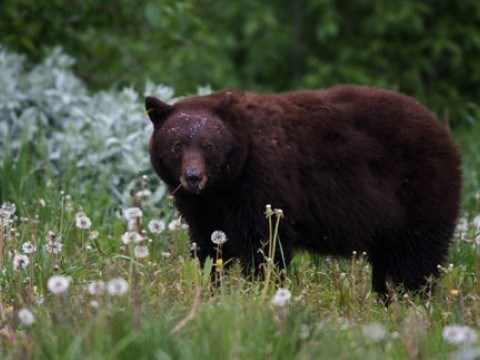In the Whistler area, Vaccinium berries - huckleberries and blueberries - are roughly five weeks behind, which means as we near mid-September there is no high elevation berry crop.
The highest elevation at which bears are now berry feeding (Sept. 9) is 4,200 ft, that's usually where bears are berry feeding in late July and early August.
At 5,000 feet there are green berries of mixed swell -1/2-3/4 - with isolated patches (very light) of ripening oval-leaf blueberries, which ripen ahead of black-huckleberry.
Sorbus, which ripens secondary to Vaccinium, may not ripen above 5000ft at all this season.
Because of delayed berry ripening mid-mountains (3,000-4,000ft), bears have remained in the valley to forage Vaccinium and now peaking Sorbus (Mountain Ash).
The high elevation (4,500-6,000ft) berry crop is not ripe and will likely not see full ripening because of uneven phenology (the scientific study of periodic biological phenomena, such as flowering, breeding, and migration, in relation to climatic conditions) due to prolonged heavy snowpack and cooler/wetter climate from May to July. If sunny days persist into late September, berry ripening could reach 5,500ft, but likely with limited abundance.
The problem with berry ripening into mid-September is that overnight recovery gets progressively heavier (cooler and wetter) slowing down ripening and increasing frequency of berry rot, which I am now seeing. Still, each sunny day gives us more berries and all we can hope for is sunny, warm weather as long as possible.
The flipside is that nearing two months without significant rain will also stress plants and "shutdown" berry size and increase shrivel.
Berries do not adapt well to extreme scales of temperature and/or precipitation.
Chance Creek (<4,000-ft) and Indian River (first 10km in) have heavy berry abundance.
However, bear activity and signs are not proportionate to berry availability. I've had cameras set-up in ripe, super-thick berry patches for over a week and no bears, but I also do not know these areas like I do the ski area population.
I'm wondering if over the last few years there has been a sharp drop in bear numbers throughout the corridor with an increase in roadkill, conflict kill, and competition among bears post-2010's poor berry crop.
Or bears could be just feeding at lower elevations and haven't moved into these habitats yet, although I think there are large pockets in the Sea to Sky corridor with very low bear numbers. Maybe these areas would be ideal for the translocation of young Whistler males to?
Bear populations are cyclic and 2010-11 is going through one of the lowest cycles of population recruitment - seven cubs total, with two lost, leaving five cubs - and combined high mortality.
Bears have emerged in 2011 in generally poor condition (because of the poor 2010 berry crop) especially the females. Large males (that did not consume non-natural foods) emerged in the best condition but are now showing visual weight loss.
In early July, when it was clear bears were not going to get valley berries on time and because they were skinnier than usual (from 2010), male bears especially, pushed hard at the village for non-natural foods and they were rewarded daily.
I saw as many as six males and two females moving through the village one early morning to forage multiple overflowing garbage bins during Crankworx. The blue sidewalk containers are not even moderately bear proof anymore.
The worst areas I have seen recently are in the Upper Village area where the Farmers' Markets are held.
Unfortunately, I guess that is a large step backward in bear management for the village areas.
Meanwhile Jeanie and her cub have been bumping around a lot in the ski area and from alpine to valley because of lack of berries and competition with other bears.
She has had limited berry feeding and you will see that as she is visually thinning.
Single females outrank mothers with offspring so resident single females have been bumping her all over the ski area.
As bears experience a shortage in berries, they get increasingly competitive with each other.
I have not observed Jeanie accessing or consuming non-natural food with the exception of running away with empty plastic bags. Will Jeanie continue to come to the valley? Probably until enough berries are available higher that she can forage securely away from other bears.
From what I've seen, the best response to Jeanie is keep it clean and push her away consistently and hard. She seems to give up easier as she gets older, but if that high elevation berry crop does not produce, she will be back...biology and historic poor garbage management dictates it.
The Whistler Blackcomb ski area has been very quiet for bears this year with the loss/absence of Katie and Zoe, two long-term resident mothers and a significant decline in alpha males and sub-adult age classes. It's been a strange bear-viewing season, but scientifically, interesting.




